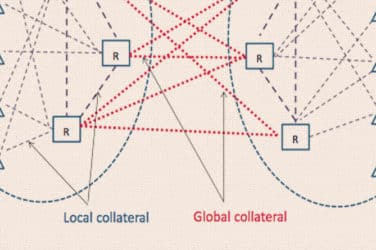
British regulators are trying to shed light on an opaque yet growing part of the capital markets known as collateral swaps, which involve high-value transactions between financial institutions.
The U.K.’s Financial Services Authority has issued finalized guidance on collateral swaps. The FSA says it plans to extend this effort to all forms of collateralized borrowing transactions (i.e., not just collateral upgrade transactions). This second phase will define collateralized borrowing and may include work on data collection and ways to facilitate market transparency.
A collateral swap is a form of secured lending whereby one counterparty transfers relatively liquid assets to another in exchange for a pledge of less liquid collateral.
In a typical collateral swap, a bank holding a portfolio of asset-backed securities or other relatively-illiquid securities will transfer these assets to a pension fund or insurance company, which, in return for a fee, delvers a portfolio of more liquid collateral such as high-grade government bonds.
“The collateral swap market is extremely opaque,” said Dan Awrey, a law professor at Oxford University, in a 2011 paper. “Nobody knows with any certainty how big this market is, who the major players are or the size of the aggregate exposures.”
Although collateral swaps are currently bilateral transactions, the possibility exists that they could be moved to an exchange or MTF as part of a general trend toward greater transparency in the OTC derivatives market.
“While swaps may contribute to systemic risk, the transparency that is afforded by moving swaps on to an exchange could have the function of decreasing systemic risk, since regulators have the ability to track them,” Louis Caron, executive lead at SAS RiskAdvisory, a provider of commodity trading and risk management solutions, told Markets Media.
The FSA noted that in contrast to most routine stock lending transactions between insurers and banks, collateral swaps are often more complex—bigger in size, longer in duration, and involving the use of less liquid collateral, and higher counterparty concentration (due to the size of the transactions).
If such transactions were undertaken on a widespread basis, “they could increase the interconnectedness of the banking and insurance sectors, and therefore pose a greater risk to financial stability”. the FSA said. “A banks failure could lead to a greater systemic impact if it, in turn, caused failure or distress among a set of connected insurers,” it added.
The FSA guidance recommends that firms upgrade their operational and legal risk review processes to ensure the enforceability and legal effectiveness of collateral arrangements in all relevant jurisdictions, including in the event of a bankruptcy of the counterparty.
The decision on whether collateral swaps might be subject to central clearing requirements under European Market Infrastructure Regulation will be up to regulators.
“Questions regarding trading and clearing of collateral swaps go to ESMA [the European Securities and Markets Authority], which is responsible for writing the technical standards for OTC clearing as defined by EMIR,” an industry source told Markets Media.
SIX x-clear, the Swiss-based clearing house, is reportedly in discussions with Swiss insurers regarding extending its existing securities lending infrastructure to develop a collateral swap service.
“We are in discussions with insurers and agents who package up collateral swaps, with a strong focus on the Swiss market where the major insurers are,” said Tomas Kindler, head of clearing relations at SIX Securities Services, according to a published report. “There is going to be a huge increase in demand for collateral, but asset managers and insurers, who sit on piles of high-quality collateral, have some reservations about lending it out due to the counterparty risk.”





